Fruit Tree Guilds: Making Your Trees Healthy and Happy
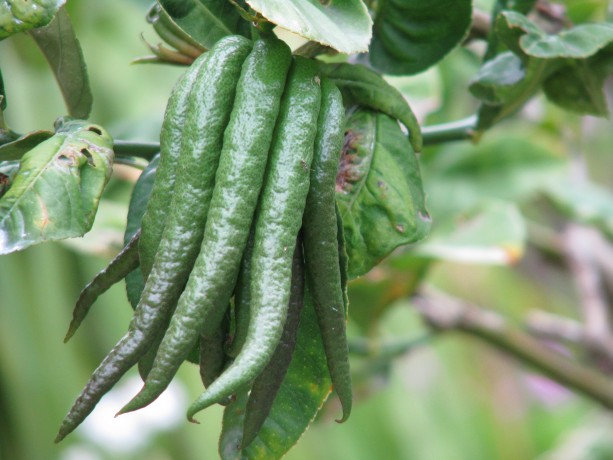
A guild in permaculture terms is, as you know, an arrangement of symbiotic plants that serve as a plant community for the benefit of the whole. Visitors to Finch Frolic Garden often remark that planting guilds sounds so difficult; that they’d need to study so much about plants that it would be impossible for them to do. Not so. However, it isn’t just a whole bunch of plants planted so that they are stepping on each other’s shoes. The typical permaculture plant guild is defined by plants which do these functions: an upper canopy tree (shade, mulch from falling leaves, deep tap roots, roosting for birds which poop, hunt, etc., traps humidity, catches and filters rain and fog moisture), a lower canopy tree (same functions but shorter), a ground cover (habitat for small hunters and moisture trap), a miner plant (deep tap root to bring nutrients from deep in the soil to its leaves which deliver said nutrients when they decompose, and tap root breaks up soil and gives passage for water and worms), a nitrogen-fixing plant (works symbiotically with bacteria to trap nitrogen from the atmosphere on root nodules, which release into the soil when the top dies), and a pollinator-attractor (flowers for bees and all the tiny native bees, wasps and flies).
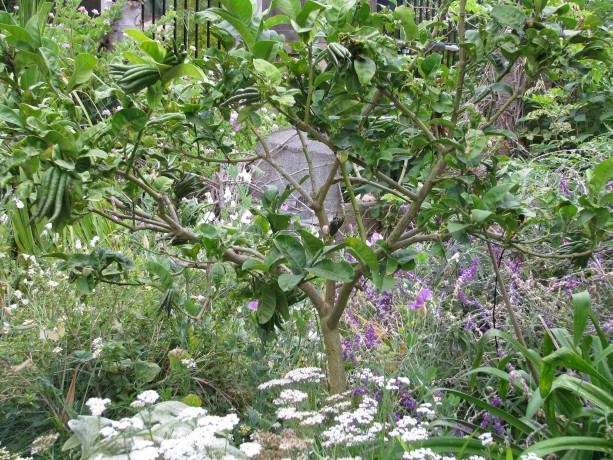
The formula isn’t that complicated. I challenge you to come up with an example of each right now. Yes, you can do it. (Dum dee dum… I’m waiting for you to be done before I move on. ) Have it? Okay, here’s a quick example. Mulberry, dwarf peach, strawberries, carrots, sweet peas, dwarf yarrow and fava beans. The canopy trees will lose their leaves allowing sun to warm the understory plants in the winter. Strawberries make an excellent ground cover that grows food and loves the fungus-rich loam made by decomposing leaves. Carrots like cool weather and will thrive until ready to be pulled (and tops broken off and thrown on the ground) about when the trees fully leaf out. Sweet peas attract insects, smell great, and as a bonus are nitrogen fixers, and can twine up the tree trunks. Dwarf yarrow helps choke out grass, is used for many purposes including as a dye plant, and its flowers are clusters of small flowers perfect for the tiny pollinators, and bush peas are completely edible and also fix nitrogen. See? Easy.
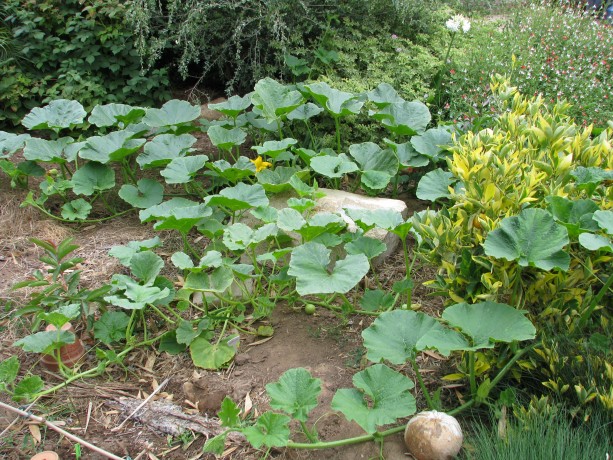
I have many, many trees which were all planted at the same time, and some of them have been neglected. A combination apple tree had been planted in extremely heavy clay and it hasn’t grown much in two years although it keeps trying to produce fruit. Bermuda grass (I cross myself when I mention it) has infiltrated the area to about four inches down. It is helping to break up the clay, but it is also choking out everything else. Plant guild time.

Last weekend I spent about three hours in the morning (mercifully before the June gloom dissipated so I didn’t roast in the heat) digging up and pulling out as much Bermuda grass as I could from the clay. I’d even soaked the area well the night before. That was the stuff of cob ovens. When I’d finally cleared past the tree (I’ll continue another day; there’s only so much of that my hands can take!), I shoveled in some pigeon guano that my good friends up the street deliver to me (tied with a ribbon! Christmas comes all year for a gardener!). The guano is very high in urea… you can smell the ammonia, but it also has feathers, corn and pigeon peas in it. Pigeon peas are a perennial legume that set nitrogen and produce wonderful pea pods for stir-fry. I watered it in well.
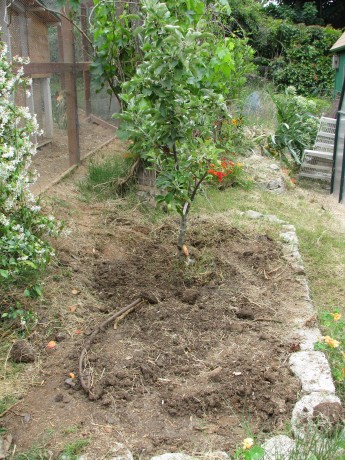
I had purchased some plants for the area, but to keep costs down just chose some that would fill out and help choke out the angry Bermuda grass bits yearning for revenge. Also, the tree is close by Harry Mud, the cob oven, so I wanted pizza-themed plants for easy picking. I planted strawberries right by the trunk inside the gopher cage in which the tree is planted. They will help retain moisture without compromising the bark of the tree. You never want to pile mulch up around the base of a tree above the root ball because you will rot your tree.
I also planted a tomato, a perennial basil, garlic chives all around the edge (bug protection), sunflowers, a prostrate rosemary and French tarragon. The pigeon peas and corn will very likely sprout. What I didn’t have was an upper canopy, but the tree is on the east side of a shed which protects it from the worst of the summer afternoon sun, and there is a grapevine nearby which produces leaf litter. When daffodil bulbs are readily available in the late Fall I’ll plant a ring of them around the drip line. Gophers don’t eat them, they help keep away the grass, they break up the soil and they are one of my favorite flowers (ranking second to sweet violets). All these plants as they grow up, down and across will help the apple tree, and the apple tree will help them. All of them produce food within easy reach of the cob oven and outdoor dining, are attractive and smell good, too. The tree should flourish. I don’t kid myself that I won’t be pulling Bermuda grass in the future, but the plants will help control it by shading and crowding out.
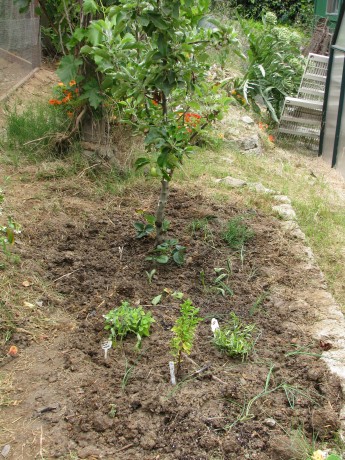
If you have citrus trees you should plan a little differently. When trying to understand a plant, think of where it came from and in what growing conditions it thrived. Avocados are from South America, with humidity, rainfall, protection from intense heat, deep leaf litter and adequate drainage. Stonefruit are from areas with cold winters; their leaf drop keeps the roots protected from the freezing that triggers the trees to set fruit (chill factor).

We think of citrus trees perfuming the air of Spain, Greece or Arabia, but actually they come from Southeast Asia and before that, New Guinea and Australia. All of these places have warm or hot temperatures and plenty of sunlight. Although you can plant stonefruit close together, for citrus it is best to ensure that the trees receive lots of direct sunlight or they will drop leaves and have stunted growth.
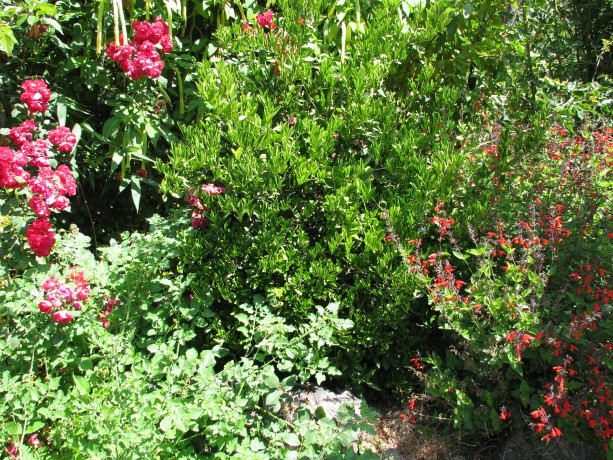
Raking all the leaves out from under your trees is so wrong. The tree drops leaves because it needs them on the ground around its roots, not because its careless or its waiting for a human to come by and clean up its mess. Leaf mulch makes the ideal conditions for microbial growth and perfect soil, so let it sit. Augment the mulch by giving your tree company of other plants. Unless the tree is allelopathic (secretes a substance that keeps anything from rooting nearby so that it doesn’t like competition, such as walnuts and eucalyptus) then in nature it reseeds close by and allows other plants to grow under it. Give your trees some appropriate company, and you’ll be rewarded with lots of food, medicine, habitat and very little work except for harvesting. Can’t beat that with a stick.
2 Comments
Diane
Hi Deana,
good for you for planting a food forest! For the overall health of citrus trees in the long run, I wouldn’t plant between their trunk and dripline. They have lots of surface (feeder, as you point out) roots and therefore other shallow-rooted plants are competition. I take my cue from the growth habit of mature, unpruned trees. Citrus and avocado grow right to the ground, like a big ballroom gown. They shade out competitors, drop leaves and fruit to hold soil moisture and to feed the kind of microbes that produce what they need for nutrition. Grass and weeds are particularly bad for citrus. Upright trees such as stonefruit invite in plants near their trunks. I sheet mulch around citrus and avocados, replicating what they would do themselves, or in what conditions a seedling might come up in, if the tree was in its native habitat. This is especially important since nursery stock is pruned up into unnatural lollipop shapes. Remember to reduce watering if you do sheet mulch by at least 10% (1 inch of mulch reduces watering by 10%) so you don’t overwater. Planting aromatic herbs between citrus trees, however, is a very good idea. Lavender, sage, rosemary, marjoram, thyme…any of the woody aromatics. They can be harvested (for sale or use) or just cut back (and used for mulch!) if they grow too large, but allow them to flower. They will increase your yield by attracting pollinators (remember that honeybees are European, and there are hundreds of native pollinators in North America that are very tiny),and confuse the ‘bad bugs’with their scent. The only type of plant that I would consider growing under a young citrus or avocado would be an annual legume vine trained up the trunk. If there is frankia in the soil then the legume (peas and beans,etc.) will fix nitrogen that will be released when the plant dies or is cut back. Most importantly is to have the vine cover the tender exposed trunks (that lollipop shape again)against sun scald when summer rolls around. The trees will really love the hugelkultur. Since your trees are small yet, you will have plenty of room around them so you can still plant guilds between trees and yet not be over their roots, until the trees grow larger. My suggestion is to sheet mulch around the young trees (be careful to keep it several inches from the trunk) then add circles of guild plants outside of that. I hope this helps! Diane
Deana
I’m growing a food forest and using what I know about edible landscaping/permaculture in SW Florida. Many of the resources we have do not discuss plants that can grow in this climate. For our citrus trees, we are often told do not plant around the feeder roots (from the trunk to the drip line). However, I’ve experimented a bit and found that the citrus seem to grow the same either way (so far). I have two citrus producing at this time, 4 not producing yet, and I have not planted over their feeder roots. Do you suggest planting a guild in this area (the trunk to the drip line?) I am preparing a hugalkulture type area for three new citrus trees (grapefruit, naval orange, and blood orange); do you think it would be good to plant a guild throughout that group of trees at the same time?